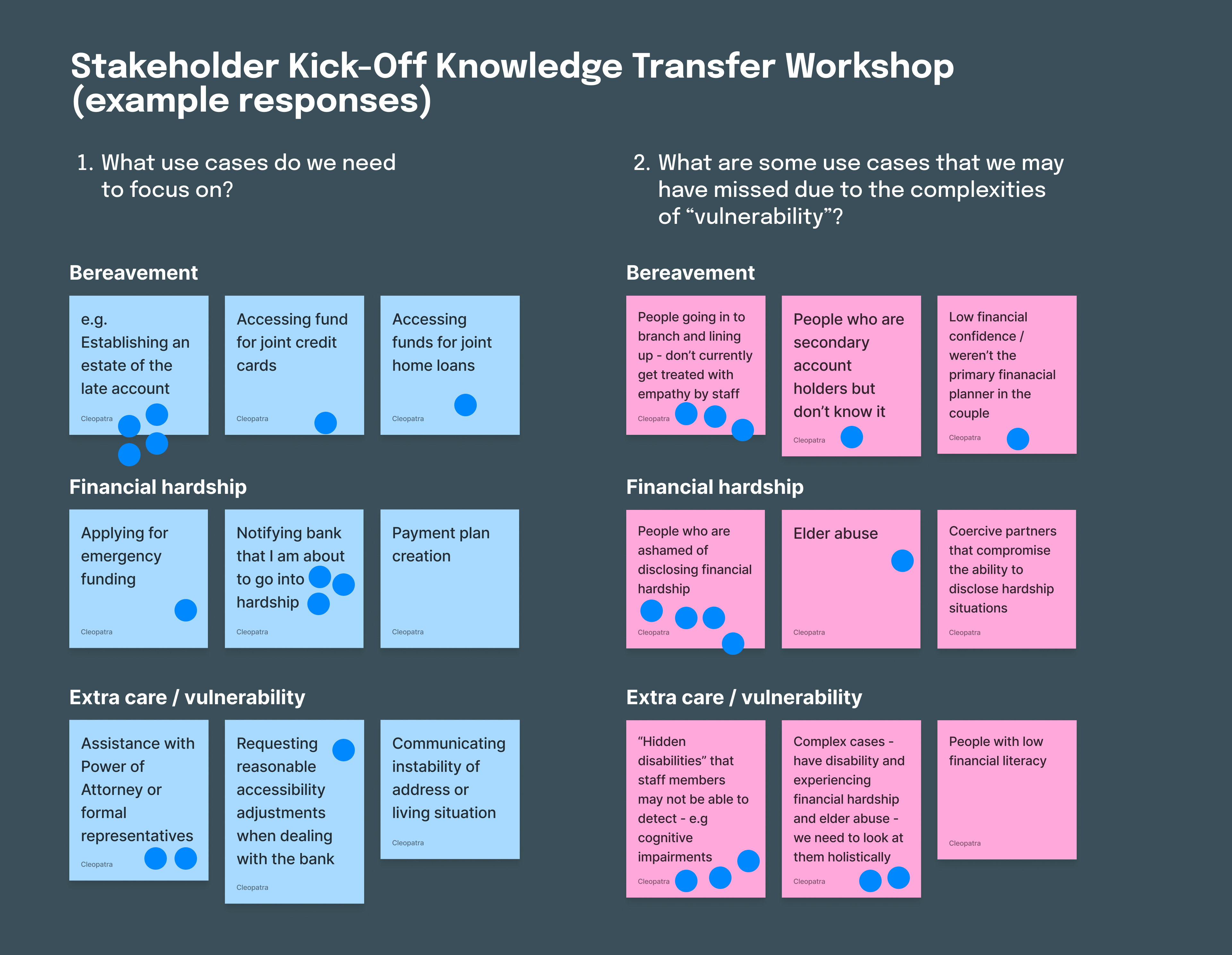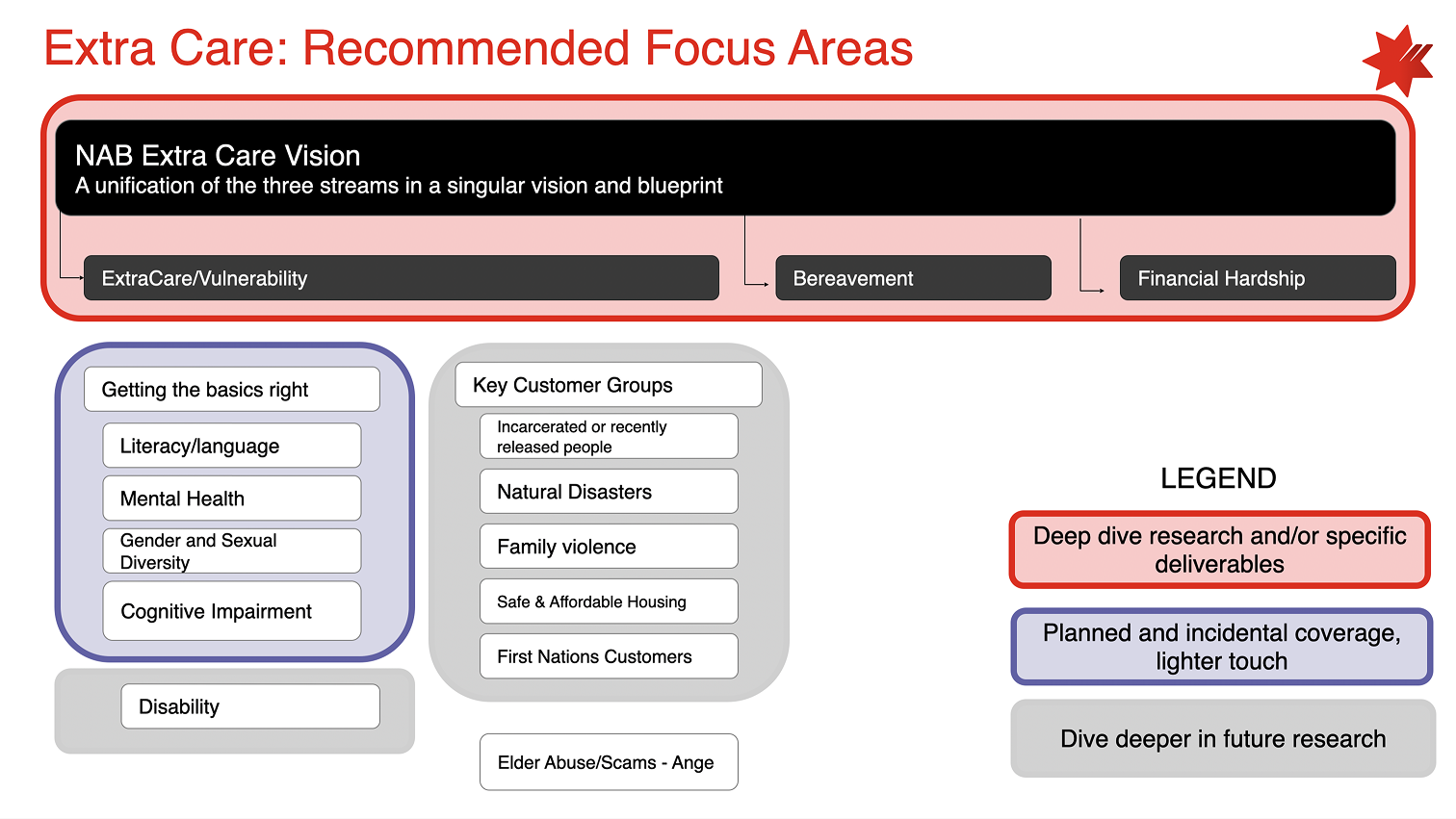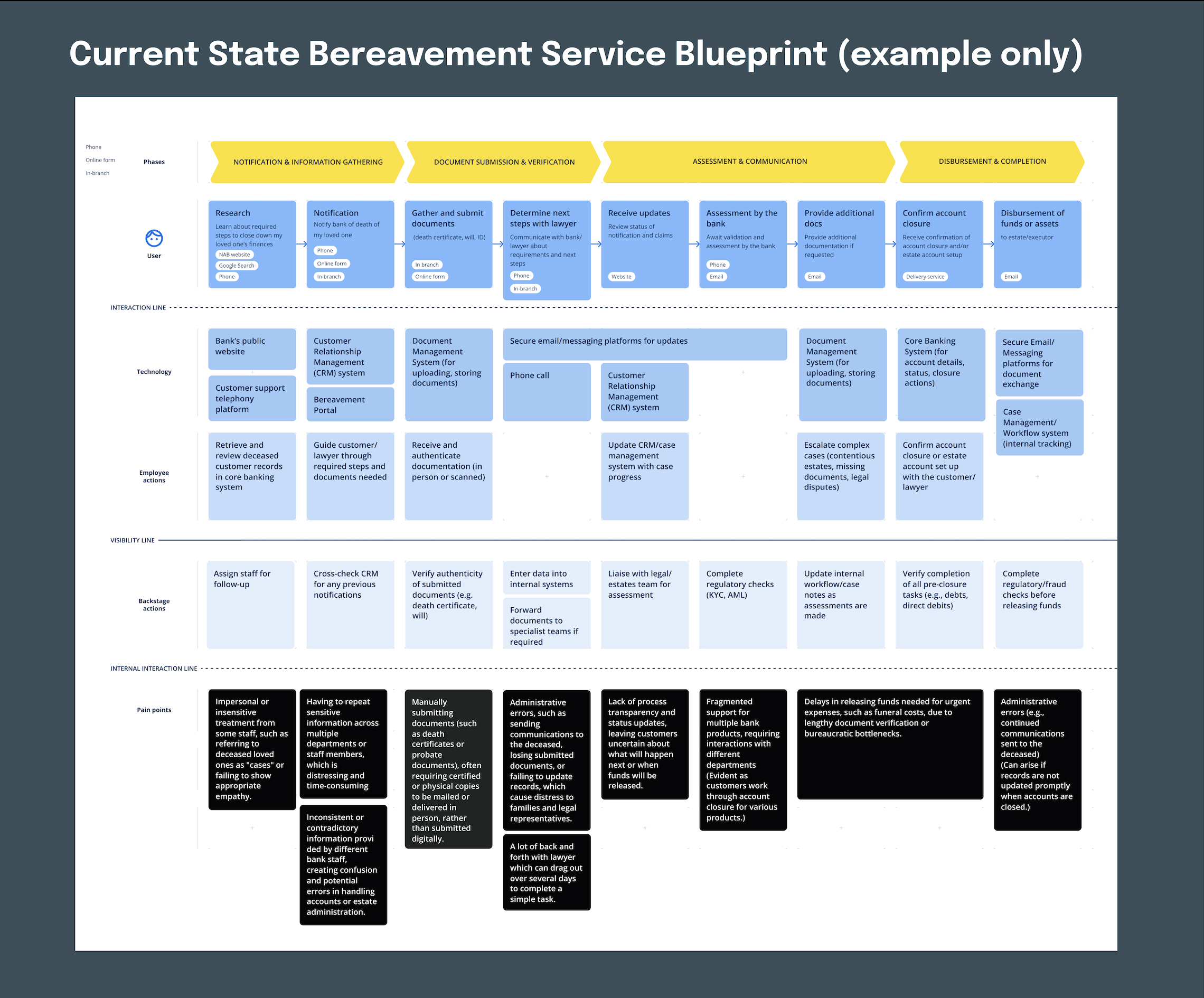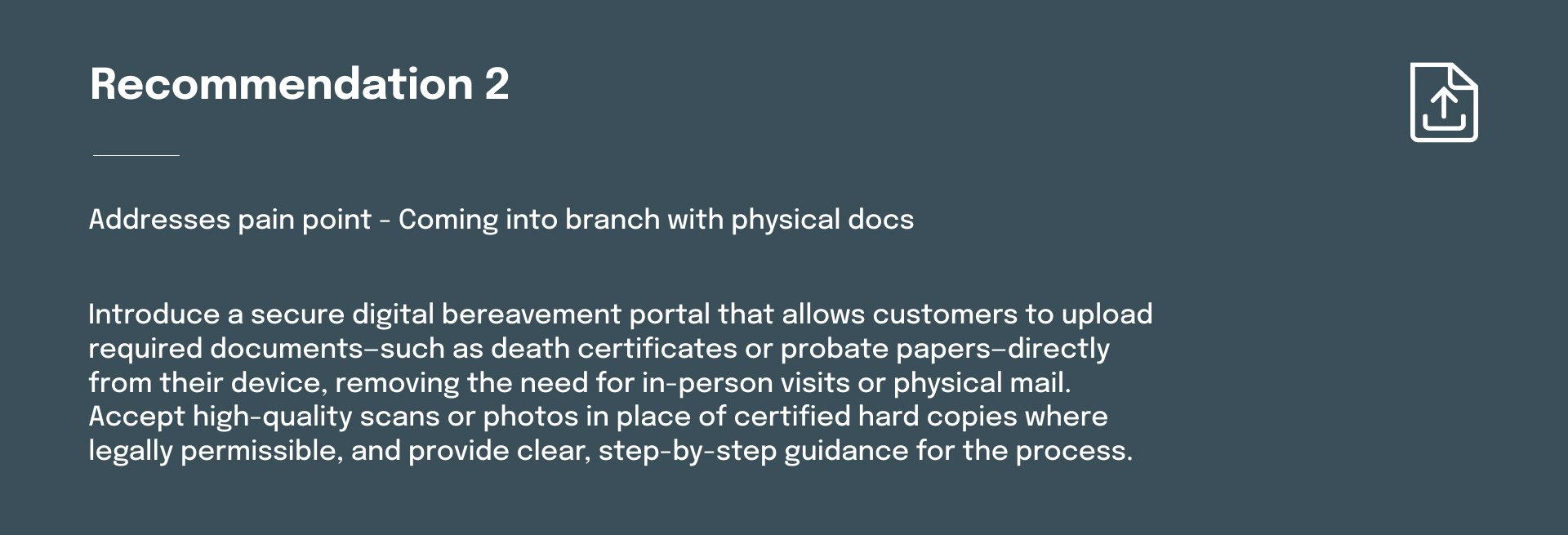Providing a New Service Model for Vulnerable Customers at National Australia Bank
Role
Relationship building, workshopping, defining scope, onboarding researchers, hands-on strategic research including 1:1 interviews
I partnered with 2 service design contractors.
I partnered with 2 service design contractors.
Duration
3 months full time
Organisation type
Large org - Big 4 Bank
Design approach
Kick-off new relationships
I was heavily involved in kicking off the initiative well and maintaining momentum.
I built relationships with a 30+ person stakeholder group with competing priorities and little experience working with service designers. I naturally created a stakeholder map that charted the reporting line to each executive.
I met with each stakeholder group 1:1 to make them feel seen and heard, consistently showed up in their part of the office on predictable days and identified their preferred working styles and priorities.
I built relationships with a 30+ person stakeholder group with competing priorities and little experience working with service designers. I naturally created a stakeholder map that charted the reporting line to each executive.
I met with each stakeholder group 1:1 to make them feel seen and heard, consistently showed up in their part of the office on predictable days and identified their preferred working styles and priorities.
Project planning
I took on detailed project planning so that the team could orchestrate multiple activities in sequence and at speed.
We shared the high level project plan with stakeholders in weekly stand ups with 2-3 weeks of buffer built in after primary research was scheduled to finish.
We shared the high level project plan with stakeholders in weekly stand ups with 2-3 weeks of buffer built in after primary research was scheduled to finish.

AI design workflow
Problem solving how to revise my first sell-in pitch
Consult Claude AI after I understood why Product didn’t want to initially invest in the Discovery process. Compared to other AI’s, one of Claude’s strengths is providing advice for situations that require emotional nuance.
Consult Claude AI after I understood why Product didn’t want to initially invest in the Discovery process. Compared to other AI’s, one of Claude’s strengths is providing advice for situations that require emotional nuance.

Our high-level project plan.
Workshopping for knowledge transfer
I spearheaded and conducted custom workshops to collaboratively uncover current state use cases, systems, requirements, teams, processes, key stakeholders, assumptions, legislation and stakeholder success metrics to inform our primary and secondary research focus.
Recruitment for 1:1 interviews
I initially took care of recruitment across all "Extra Care" streams.
We went with a split recruitment strategy. Some customer types were tricky to recruit via Farron (e.g. people who experienced domestic violence or financial hardship) so we partnered with community outreach organisations such as Uniting and Mercy Health.
It added extra overhead and made distributing incentives a little more complicated, but it was the right thing to do by the community and our stakeholders.
We went with a split recruitment strategy. Some customer types were tricky to recruit via Farron (e.g. people who experienced domestic violence or financial hardship) so we partnered with community outreach organisations such as Uniting and Mercy Health.
It added extra overhead and made distributing incentives a little more complicated, but it was the right thing to do by the community and our stakeholders.
AI-assisted workflow

First-draft ontology map using training material
We could centralise ops team member training material (e.g. wikis, user manuals for key systems, system error reports), and ask ChatGPT(Plus) to generate a first-draft ontology map - pending company policy around sharing internal data with 3rd parties.
The aim would be to define domain-specific jargon in simple terms, map how it all relates to each other, quality check it with an experienced team member then disseminate within the squad to speed up context building.
We could centralise ops team member training material (e.g. wikis, user manuals for key systems, system error reports), and ask ChatGPT(Plus) to generate a first-draft ontology map - pending company policy around sharing internal data with 3rd parties.
The aim would be to define domain-specific jargon in simple terms, map how it all relates to each other, quality check it with an experienced team member then disseminate within the squad to speed up context building.

Note: I've re-created this artifact due to non-disclosure and privacy agreements.
Scoping
After consulting with one of the bereavement Directors, I ensured that business customers were given a lighter touch than personal customers. 2 out of 3 key journeys were given priority given the research timeframe. I received sign off on scope at the first attempt.
Once the two service design contractors joined, my focus was on bereaved customers. I wrote a discussion guide that addressed gaps in the stakeholder-created customer journeys that were documented in the workshop.
Once the two service design contractors joined, my focus was on bereaved customers. I wrote a discussion guide that addressed gaps in the stakeholder-created customer journeys that were documented in the workshop.
Desk research & expert interviews
I reviewed any existing stakeholder generated / industry reports to identify the gaps we needed to fill during customer and expert interviews.
For bereavement, we spoke to experts from the frontline contact centre, those who established an estate of the late account or who took care of access rights to the deceased person's funds.
For bereavement, we spoke to experts from the frontline contact centre, those who established an estate of the late account or who took care of access rights to the deceased person's funds.

Part of our scope document for the entire Extra Care program of work.

Image created using Midjourney AI.
1:1 interviews
For bereavement, we recruited customers who'd had a partner vs a loved one pass away, people who'd had varying levels of time to mourn, people who had gone through a lawyer vs did the estate administration themselves and other criteria.
It was clear that most people were not ready for the amount of work that went into administratively moving on their loved one's estate.
It was clear that most people were not ready for the amount of work that went into administratively moving on their loved one's estate.
Concept testing
During the interviews we asked a series of questions and tested four concepts that aligned to stakeholder assumptions:
Concept 1: Ability for a bereaved customer to book in-branch appointments
Concept 2: Copy for a Bereavement webpage - testing whether a compassionate vs task-focussed tone-of-voice was better received
Concept 3: An entirely online experience to initiate, manage and track the closure of the estate
Concept 4: Ongoing support for customers experiencing Bereavement such as a councillor provided by the bank.
Concept 1: Ability for a bereaved customer to book in-branch appointments
Concept 2: Copy for a Bereavement webpage - testing whether a compassionate vs task-focussed tone-of-voice was better received
Concept 3: An entirely online experience to initiate, manage and track the closure of the estate
Concept 4: Ongoing support for customers experiencing Bereavement such as a councillor provided by the bank.

Example current state service blueprint - I've re-created a simpler version of this artifact due to non-disclosure and privacy agreements.

Examples of concepts to address customer pain points found during discovery that could be tested using prototypes or experiments.

Outcomes
To make sense of the landscape, I reviewed the existing research and mobile app. This included:
• Existing contextual inquiry and landscape review insights
• Complaints data
• Live chat data
• Stakeholder interviews with the client
Some key insights:
• A surprisingly large volume of customers use the contact centre to confirm their flights prior to travel (esp first-time flyers)
• Many customers turn up on the day of flight, unaware that they have missed a critical step prior to flight (e.g., check-in)
• Existing contextual inquiry and landscape review insights
• Complaints data
• Live chat data
• Stakeholder interviews with the client
Some key insights:
• A surprisingly large volume of customers use the contact centre to confirm their flights prior to travel (esp first-time flyers)
• Many customers turn up on the day of flight, unaware that they have missed a critical step prior to flight (e.g., check-in)
• The Jetstar mobile app was launched and has an average 4.8 star rating on the App Store.
• Positive task completion scores for key tasks provided confidence to the reduce cost to serve.
Customers with low tech confidence and little booking experience could complete high usage tasks with ease using the new solution.
• Concept-testing for new Manage My Booking experience was well-received by research participants.
• We hit all design milestones agreed to at the start of the initiative.
• Positive task completion scores for key tasks provided confidence to the reduce cost to serve.
Customers with low tech confidence and little booking experience could complete high usage tasks with ease using the new solution.
• Concept-testing for new Manage My Booking experience was well-received by research participants.
• We hit all design milestones agreed to at the start of the initiative.
• High value insights and a future state concepts for vulnerable customers were co-created with the community and stakeholders.
• NAB had a roadmap to share with ASIC so that they remained compliant with industry service standards.
• Our Bereavement stakeholders had a clear, research-backed roadmap to rationalise the combination of internal teams.
• Other delivery-focussed success metrics like “time-on-task”, “customer satisfaction” and “reduction in cost to serve” were identified and agreed to by the entire stakeholder group.
• NAB had a roadmap to share with ASIC so that they remained compliant with industry service standards.
• Our Bereavement stakeholders had a clear, research-backed roadmap to rationalise the combination of internal teams.
• Other delivery-focussed success metrics like “time-on-task”, “customer satisfaction” and “reduction in cost to serve” were identified and agreed to by the entire stakeholder group.
